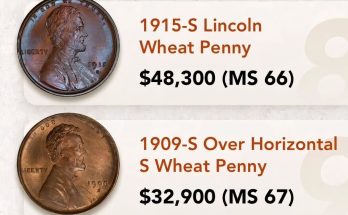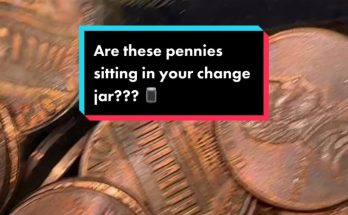UK TOP 3 Pennies You Should NEVER Spend: They’re Worth a Fortune!
Stop before you drop that loose change into a charity box or an old piggy bank—you could be holding a small copper disc worth more than a luxury car. The unassuming one-penny coin, the lowest denomination in the UK, has a secret life far removed from its humble face value. For coin collectors, or ‘numismatists,’ certain pennies are the stuff of legend, having sold for tens of thousands of pounds at auction. They are relics of historical quirks, minting errors, or ultra-low production numbers, and finding one in your spare change is the equivalent of winning a small lottery.
The difference between a 1p coin worth one penny and one worth a fortune often comes down to a tiny date or a subtle detail missed by millions. These hidden treasures represent a captivating intersection of history, error, and rarity. We’ve uncovered the UK’s Top 3 most valuable pennies—the ones you should NEVER spend.
1. The Holy Grail: The 1933 George V Penny
At the absolute pinnacle of British numismatic rarity stands the 1933 George V Penny. This coin is not just rare; it is legendary. Its astronomical value stems from a dramatic decision by the Royal Mint. Due to a large stockpile of pennies from the previous year, no new ones were scheduled for general circulation in 1933.
However, a small number were struck, specifically for ceremonial purposes, such as placing beneath the foundation stones of new public buildings, and for the Royal Mint’s own collection. It is widely believed that only seven genuine examples of the 1933 penny were ever struck. The exact whereabouts of some remain a mystery—with one famously stolen from a church foundation stone in 1970 and another still believed to be sealed beneath Senate House at the University of London.
Because so few exist and they were never meant for circulation, they are the ‘Holy Grail’ for British coin collectors. When a genuine 1933 penny comes up for sale, it commands a spectacular price. One example sold at auction for an incredible £72,000, with other estimates placing their potential value at over £200,000 today depending on their condition and documented history. If you somehow find a 1933 penny, you are quite literally holding a piece of history worth a life-changing sum.
2. The Metal Mix-Up: The 1992 Bronze 1p
The 1990s brought a significant, yet easily overlooked, change to the UK’s copper coins. Before 1992, the 1p coin was made from a heavy bronze composition. Due to the rising cost of metals, the Royal Mint switched to a cheaper, lighter, and crucially, magnetic copper-plated steel core in 1992.
However, a very small number of the 1992 1p coins were accidentally struck on the old, heavier bronze blanks—the same material used for the earlier coins. The mint record suggests that while over 253 million steel pennies were issued that year, a tiny fraction—perhaps only a few thousand, or even less—were the valuable bronze version.
How can you spot this fortune-making fault? You need a simple magnet. A standard 1992 penny (copper-plated steel) will be magnetic. The rare, valuable, error version (bronze) will not stick to a magnet. While not worth as much as the 1933 penny, finding this non-magnetic version from 1992 is a genuine possibility in your change and could fetch a high premium from a collector looking to complete their set, proving that sometimes, what isn’t there is what counts most.
3. The Stealth Release: The 2018 and 2019 NIFC 1p
For more modern coin hunters, the years 2018 and 2019 hold a hidden jackpot. In these two years, the Royal Mint did not issue any 1p coins for general circulation. They were only produced in “Brilliant Uncirculated” or “Proof” quality for inclusion in special annual collector coin sets.
This means that any 1p coin dated 2018 or 2019 that you find in your pocket, wallet, or till drawer has been broken out of a collector’s set and spent at face value—a huge mistake by its previous owner! Because these dates have a ‘Not Intended For Circulation’ (NIFC) status, they are significantly rarer than pennies from other years.
Although a circulating NIFC coin will be worn, its scarcity makes it highly desirable. An uncirculated example can command a decent price, but even a circulated one is a trophy for a collector. The tiny mintage figures for those years—far below the typical hundreds of millions—make them a must-find. It’s an easy check: simply look at the date!
The lesson is clear: your loose change is a potential treasure chest. Whether it’s the near-mythical 1933 penny, the metal anomaly of the 1992 bronze coin, or the modern scarcity of the 2018 and 2019 dates, the smallest coin you possess could be the most valuable. So, the next time you find a UK penny, remember: check the date, check the metal, and check the details. You should NEVER spend these small coppers—they could truly be worth a fortune!



